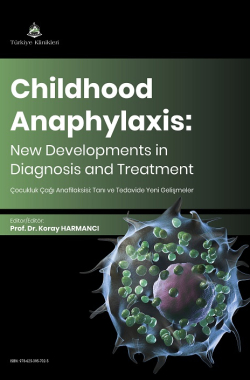ACUTE MANAGEMENT OF ANAPHYLAXIS
Gizem Köken
Gazi University, Faculty of Medicine, Department of Pediatric Immunology and Allergic Diseases, Ankara, Türkiye k
Köken G. Acute Management of Anaphylaxis. In: Harmancı K, editor. Childhood Anaphylaxis: New Developments in Diagnosis and Treatment. 1st ed. Ankara: Türkiye Klinikleri; 2025. p.251-257.
ABSTRACT
Anaphylaxis is a medical emergency that requires rapid identification and treatment. Once anaphylaxis is diagnosed, the management algorithm should be immediately initiated. In addition to the written emergency protocols determined through a multidisciplinary approach in healthcare facilities, patients with a history of prior anaphylaxis should also have standardized and easily accessible written action plans in place. After removing the suspected trigger, the patient’s overall condition should be rapidly assessed. After removal of the suspected trigger, the patient’s overall condition should be rapidly assessed, followed by prompt and simultaneous initiation of calling for help, positioning the patient supine, and starting treatment. The first-line treatment for anaphylaxis is adrenaline (epinephrine). Second-line treatments include such as antihistamines, glucocorticoids, inhaled beta-2 agonists, and glucagon.
Keywords: Adrenaline; Anaphylaxis; Children; Epinephrine; Management; Treatment
Kaynak Göster
Referanslar
- Muraro A, Worm M, Alviani C, Cardona V, DunnGalvin A, Garvey LH, et al. European Academy of Allergy and Clinical Immunology, Food Allergy, Anaphylaxis Guidelines Group. EAACI guidelines: Anaphylaxis (2021 update). Allergy. 2022;77(2):357-377. [Crossref] [PubMed]
- Cardona V, Ansotegui IJ, Ebisawa M, El-Gamal Y, Fernandez Rivas M, Fineman S, et al. World allergy organization anaphylaxis guidance 2020. World Allergy Organ J. 2020;13(10):100472. [Crossref] [PubMed] [PMC]
- Höfer V, Dölle-Bierke S, Francuzik W, Ruëff F, Sabouraud-Leclerc D, Treudler R, et al. Fatal and Near-Fatal Anaphylaxis: Data From the European Anaphylaxis Registry and National Health Statistics. J Allergy Clin Immunol Pract. 2024;12(1):96-105.e8. [Crossref] [PubMed]
- Sampson HA, Muñoz-Furlong A, Campbell RL, Adkinson NF Jr, Bock SA, Branum A, et al. Second symposium on the definition and management of anaphylaxis: summary report--Second National Institute of Allergy and Infectious Disease/Food Allergy and Anaphylaxis Network symposium. J Allergy Clin Immunol. 2006;117(2):391-7. [Crossref] [PubMed]
- Orhan F, Cıvelek E, Şahıner UM, Arga M, Can D, Çalıkaner AZ, et al. Anaphylaxis: Turkish National Guideline 2018. Asthma Allergy Immunology. 2018;16:001-062.
- Simons FE, Roberts JR, Gu X, Simons KJ. Epinephrine absorption in children with a history of anaphylaxis. J Allergy Clin Immunol. 1998;101(1 Pt 1):33-7. [Crossref] [PubMed]
- Simons FE, Gu X, Simons KJ. Epinephrine absorption in adults: intramuscular versus subcutaneous injection. J Allergy Clin Immunol. 2001;108(5):871-3. [Crossref] [PubMed]
- Ellis AK, Casale TB, Kaliner M, Oppenheimer J, Spergel JM, Fleischer DM, et al. Development of neffy, an Epineph rine Nasal Spray, for Severe Allergic Reactions. Pharmaceutics. 2024;16(6):811. [Crossref] [PubMed] [PMC]
- WebMD. FDA Approves First Nasal Spray for Treatment of Anaphylaxis. WebMD. Published 2024. Accessed August 09, 2024.
- Pouessel G, Dribin TE, Tacquard C, Tanno LK, Cardona V, Worm M, et al. Management of Refractory Anaphylaxis: An Overview of Current Guidelines. Clin Exp Allergy. 2024;54(7):470-488. [Crossref] [PubMed] [PMC]
- Nurmatov UB, Rhatigan E, Simons FE, Sheikh A. H2-antihistamines for the treatment of anaphylaxis with and without shock: a systematic review. Ann Allergy Asthma Immunol. 2014;112(2):126-131. [Crossref] [PubMed]
- Gabrielli S, Clarke A, Morris J, Eisman H, Gravel J, Enarson P, et al. Evaluation of Prehospital Management in a Canadian Emergency Department Anaphylaxis Cohort. J Allergy Clin Immunol Pract. 2019;7(7):2232-2238.e3. [Crossref] [PubMed]
- Shaker MS, Wallace DV, Golden DBK, Oppenheimer J, Bernstein JA, Campbell RL, et al. Anaphylaxis-a 2020 practice parameter update, systematic review, and Grading of Recommendations, Assessment, Development and Evaluation (GRADE) analysis. J Allergy Clin Immunol. 2020;145(4):1082-1123. [Crossref] [PubMed]
- Brown SGA. Cardiovascular aspects of anaphylaxis: implications for treatment and diagnosis. Curr Opin Allergy Clin Immunol 2005;5:359-64. [Crossref] [PubMed]
- Pouessel G, Dribin TE, Tacquard C, Tanno LK, Cardona V, Worm M, et al. Management of Refractory Anaphylaxis: An Overview of Current Guidelines. Clin Exp Allergy. 2024;54(7):470-488. [Crossref] [PubMed] [PMC]

